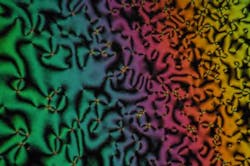'Zwitterionic' liquid crystal promises to improve performance of digital displays
Nashville, TN--Chemists at Vanderbilt University have created a new class of liquid crystals with unique properties that could improve the performance of digital displays.
The achievement, which is the result of more than five years of effort, is described by Professor of Chemistry Piotr Kaszynski and graduate student Bryan Ringstrand in a pair of articles published online on Sept. 24 and Sept. 28 in the Journal of Materials Chemistry.
"We have created liquid crystals with an unprecedented electric dipole, more than twice that of existing liquid crystals," says Kaszynski.
Electric dipoles are created in molecules by the separation of positive and negative charges. The stronger the charges and the greater the distance between them, the larger the electric dipole they produce. In liquid crystals, the electric dipole is associated with the threshold voltage: the minimum voltage at which the liquid crystal operates. Higher dipoles allow lower threshold voltages. In addition, the dipole is a key factor in how fast liquid crystals can switch between bright and dark states. At a given voltage, liquid crystals with higher dipoles switch faster than those with lower dipoles.
Commercial potential
Vanderbilt has applied for a patent on the new class of materials. Some commercial liquid-crystal manufacturers have expressed interest and are currently evaluating it.
"Our liquid crystals have basic properties that make them suitable for practical applications, but they must be tested for durability, lifetime, and similar characteristics before they can be used in commercial products," Kaszynski says.
If it passes commercial testing, the new class of liquid crystals will be added to the complex molecular mixtures that are used in liquid-crystal displays. These blends combine different types of liquid crystals and other additives that are used to fine-tune their characteristics, including viscosity, temperature range, optical properties, electrical properties and chemical stability. There are dozens of different designs for liquid crystal displays and each requires a slightly different blend.
"Zwitterionic" structure
What distinguishes the new class of liquid crystals is its "zwitterionic" structure. Zwitterions are chemical compounds that have a total net electrical charge of zero but contain positively and negatively charged groups. The newly developed liquid crystals contain a zwitterion made up of a negatively charged inorganic portion and a positively charged organic portion. Kaszynski first got the idea of making zwitterionic liquid crystals nearly 17 years ago when he first arrived at Vanderbilt. However, a critical piece of chemistry required to do so was missing. It wasn't until 2002 when German chemists discovered the chemical procedure that made it possible for the Vanderbilt researchers to succeed in this effort.
The research was funded by a grant from the National Science Foundation.
Subscribe now to Laser Focus World magazine; it’s free!
About the Author
John Wallace
Senior Technical Editor (1998-2022)
John Wallace was with Laser Focus World for nearly 25 years, retiring in late June 2022. He obtained a bachelor's degree in mechanical engineering and physics at Rutgers University and a master's in optical engineering at the University of Rochester. Before becoming an editor, John worked as an engineer at RCA, Exxon, Eastman Kodak, and GCA Corporation.

